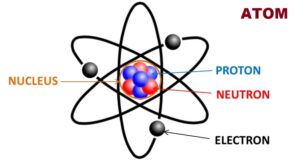What is an Atom?
What is an Atom?
Atom, smallest unit into which matter can be divided without the release of electrically charged particles. It also is the smallest unit of matter that has the characteristic properties of a chemical element. As such, the atom is the basic building block of chemistry.
An atom is defined as the smallest particle of a substance that can exist by itself or be combined with other atoms to form a molecule

Dalton’s Atomic Theory
The postulates of Dalton’s atomic theory were as follows.
- All matter is made up of small indivisible and indestructible particles called atoms.
- All atoms of the same element have identical properties but differ from atoms of other elements.
- Atoms of different elements combine together to form a compound.
- A chemical reaction is nothing but a rearrangement of these atoms.
- Atoms cannot be created or destroyed by any means.
Dalton’s theory had certain drawbacks like; today we know that atoms can be destroyed. Also, some atoms of the same elements vary in their mass(isotopes). The theory also fails to explain the existence of allotropes.
But in modern era concept of atom is based on the combining the merits of Rutherford’s atomic model and Bohr’s atomic model. All substances are made up of atoms. All atoms consist of,
- Nucleus
- Electrons
Nucleus of Atom
Nucleus is located at the center of atom. The diameter of nucleus is about 1/10000 of diameter of whole atom. Almost whole mass of atom is concentrated in its nucleus. Nucleus itself consists of two kinds of particles,
- Proton
- Neutron
Proton
Protons are positively charged particles. Charge on each proton is 1.6 × 10-19 Coulomb. The number of protons in nucleus of an atom represents the atomic number of atom.
Neutron
Neutrons do not have any electrical charge. Means, neutrons are electrically neutral particles. The mass of each neutron is equal to mass of the proton. The nucleus is positively charged due to the presence of positively charged protons. In any material, the weight of the atom and radioactive properties are associated with the nucleus.
Electrons :
An electron is a negatively charged particle present in the atoms. Charge on each electron is – 1.6 × 10–19 Coulomb. These electrons surround the nucleus. Some facts about electrons in an atom are listed and explained below,
- If an atom is having the same number of protons and electrons, the atom is electrically neutral as the negative charge of electrons neutralizes the positive charge of protons.
- The electrons revolve around the nucleus in shells (also called orbits).
- A force of attraction is excreted on negatively charged electrons by positively charged nucleus. This force of attraction works as centripetal force required for electrons revolution around the nucleus.
- The electrons which are near to nucleus are tightly bound with the nucleus and it is more difficult to pull out (remove) these electrons from the atom than those which are far away from the nucleus.
- The structure of aluminum atoms is shown in figure below-

- A definite amount of energy is required to remove the electron from its orbit. The energy required to remove the electron from the first orbit is much more as compared to the energy required to remove the electron from the outer orbit. This is due to the force of attraction excreted by nucleus on electrons in the first orbit is much more as compared to the force of attraction excreted on electrons of outer orbit. Similarly, the energy required to remove the electron from the second orbit will be less as compared to the first orbit and greater than the third orbit. Hence, we can say that the electrons in the orbit are associated with a definite amount of energy. Thus the orbits or shells are also referred as energy levels.
- The energy levels are denoted by the letters K, L, M, N, etc. Where, K is the nearest orbit to the nucleus and having lowest energy level. Conversely, the outermost orbit is having highest energy level.
- The maximum number of electrons in any energy level is given by, ‘2n2’, where, n is an integer and represents the “principal quantum number”. For different energy levels the value of ‘n’ and maximum number of electrons as given in table below.
| Sl. No. | Energy level or Orbit (shell) | Principal quantum number ‘n’ | Maximum Number of electrons (2n2) |
| 1 | K | 1 | 2 × 12 = 2 |
| 2 | L | 2 | 2 × 22 = 8 |
| 3 | M | 3 | 2 × 32 = 18 |
| 4 | N | 4 | 2 × 42 = 32 |
Modern Atomic Theory
The modern atomic theory is just little more evolved than the Dalton’s Theory. Modern atomic theory is also called as quantum theory. The concept of wave particle duality comes into picture here. It says that the electrons which are considered to be particles can sometimes behave like waves. So an atom has a nucleus which is surrounded by probability clouds. These clouds are the most probably locations of electrons. The size and shape of these clouds can be calculated by using the equations of the waves.
Read article – Units of Resistivity
Visit NCERTplanet.com for NCERT solutions and Textbook downloads




